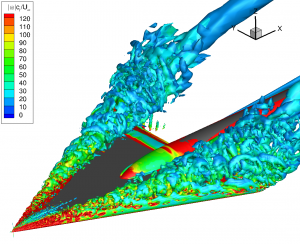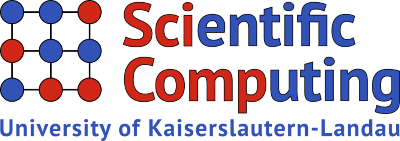Contact: Dr. -Ing. Beckett Y. Zhou, Prof. Dr. Nicolas R. Gauger
Prediction of Vortex Breakdown over a Delta Wing at High Angle of Attack
 At a sufficiently high angle of attack, large adverse pressure gradient causes the turbulent vortex over the upper surface of the delta wing to breakdown, dramatically reducing lift while increasing airframe vibration and control instability. Therefore, to reliably design an control the delta wing aircraft, it is of paramount importance to accurately predict the strength and location of vortex breakdown as well as the flow conditions at which breakdown occurs. In this joint effort with NASA Langley Research Center, we perform hybrid RANS/LES simulation (HRLES) using both SU2 and FUN3D. The SU2 DDES solver employs a new vorticity-sensitized shear-layer adapted (SLA) subgrid scale model and the modified simple low dissipation AUSM (SLAU2) flux scheme, aimed at mitigating the ‘grey area problem’ in HRLES simulation and unlocking the Kelvin-Helmholtz instability in the initial shear layer. The common mesh employed in this work was previously used in the EU project Go4Hybrid and graciously shared by J. Kok from NLR. SU2 is shown to resolve the fine-scale turbulence structures starting immediately aft of the apex of the wing. The SU2 predictions are in close agreement with experiment.
At a sufficiently high angle of attack, large adverse pressure gradient causes the turbulent vortex over the upper surface of the delta wing to breakdown, dramatically reducing lift while increasing airframe vibration and control instability. Therefore, to reliably design an control the delta wing aircraft, it is of paramount importance to accurately predict the strength and location of vortex breakdown as well as the flow conditions at which breakdown occurs. In this joint effort with NASA Langley Research Center, we perform hybrid RANS/LES simulation (HRLES) using both SU2 and FUN3D. The SU2 DDES solver employs a new vorticity-sensitized shear-layer adapted (SLA) subgrid scale model and the modified simple low dissipation AUSM (SLAU2) flux scheme, aimed at mitigating the ‘grey area problem’ in HRLES simulation and unlocking the Kelvin-Helmholtz instability in the initial shear layer. The common mesh employed in this work was previously used in the EU project Go4Hybrid and graciously shared by J. Kok from NLR. SU2 is shown to resolve the fine-scale turbulence structures starting immediately aft of the apex of the wing. The SU2 predictions are in close agreement with experiment.
Project Partners: Mike Park (NASA Langley Research Center)
Boris Diskin (National Institute of Aerospace)
Automated Mesh Generation and Adaptation for Turbulent Flow Simulations in SU2
 In this exploratory effort, undertaken jointly with mesh generation experts at the Old Dominion University and NASA Langley Research Center, an automatic grid generation procedure is coupled with the open-source SU2 solver suite. The proposed method is based on two building blocks targeting two different regions of the input geometry — a fully automated Boundary Layer (BL) approach capable of handling arbitrary geometries for the viscous region and a parallel local reconnection method for the inviscid region. The mesh thus generated is used by the SU2 DDES solver to predict the turbulent flow over a delta wing experiencing vortex breakdown. It is also planned to explore solution-based anisotropic grid adaptation for turbulent flows in the near future. Other configurations of interest include chevron nozzles and landing gear models with increasing levels of complexity.
In this exploratory effort, undertaken jointly with mesh generation experts at the Old Dominion University and NASA Langley Research Center, an automatic grid generation procedure is coupled with the open-source SU2 solver suite. The proposed method is based on two building blocks targeting two different regions of the input geometry — a fully automated Boundary Layer (BL) approach capable of handling arbitrary geometries for the viscous region and a parallel local reconnection method for the inviscid region. The mesh thus generated is used by the SU2 DDES solver to predict the turbulent flow over a delta wing experiencing vortex breakdown. It is also planned to explore solution-based anisotropic grid adaptation for turbulent flows in the near future. Other configurations of interest include chevron nozzles and landing gear models with increasing levels of complexity.
Project Partners: Christos Tsolakis, Juliette Pardue, Andrey Chernikov and Nikos Chrisochoides (ODU)
Mike Park (NASA Langley Research Center)
Boris Diskin and Hiro Nishikawa (National Institute of Aerospace)


